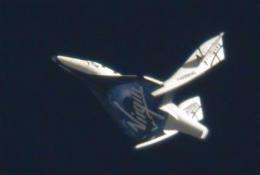This image provided by the Clay Center Observatory/Virgin Galactic shows SpaceShipTwo in full feather wing mode on a rapid descent from its drop altitude of 51,500 feet over Mojave, Calif., Wednesday May 4, 2011. The craft descended in this configuration at a near vertical angle at a rate of 15,500 feet per minute. The craft was reconfigured to normal glide mode at 33,500 feet. This photograph was taken with high powered telescopes from the ground. (AP Photo/Virgin Galactic/Clay Center Observatory, Mark Greenberg)
High over the Mojave Desert, the stubby-winged SpaceShipTwo bent itself into a near-right angle shape and plunged nearly straight downward for more than a minute before unfolding and gliding to a runway landing before an excited crowd.
The test flight Wednesday marked another milestone in Virgin Galactic's effort to be the first company to carry tourists into space.
"What an awesome way to start the day. SpaceShipTwo looked positively beautiful today on her maiden feathered flight!" Will Pomerantz, Virgin Galactic vice president for special projects, said in a tweet.
During the test, SpaceShipTwo did not fire its rocket engine for a climb into space. Instead, a mothership lifted it to 52,000 feet where it was released. It then rotated its twin tail booms upward 65 degrees, Virgin Galactic said.
As SpaceShipTwo descended almost vertically through the sky, it was slowed by the drag of the folded tail, similar to the way feathers slow a badminton shuttlecock. The reconfiguration will be a critical part of the spaceship's descent through Earth's atmosphere after suborbital trips into space.
At 34,000 feet, pilots returned SpaceShipTwo to its normal configuration and landed it like an airplane. The demonstration from release to touchdown lasted 11 minutes, including 75 seconds in the "feathered" mode.
"It flew stably," said Virgin Galactic chief executive George Whitesides.
SpaceShipTwo is based on Burt Rutan's award-winning SpaceShipOne prototype, which became the first privately financed manned rocket to reach space in 2004.
Rutan retired last month from Scaled Composites, a company he founded that built and is testing SpaceShipTwo for Sir Richard Branson's Virgin Galactic.
SpaceShipTwo's unique re-entry has been touted by aerospace experts as a way to overcome the problem of searing heat that other types of spacecraft face when they plunge back into the atmosphere at high speed.
NASA's space shuttles need a layer of thermal tiles and Russia's Soyuz rockets employ heat shields to insulate against damage during re-entry.
Another key test for SpaceShipTwo will come when engineers start powered flights into space, expected sometime this year. Until now, all the tests have been unpowered glide flights.
No date has been set for the first commercial flight from a custom-built spaceport in New Mexico.
Some 410 people have paid the full $200,000 or a deposit for a chance to experience a few minutes of weightlessness, according to Virgin Galactic.
©2011 The Associated Press. All rights reserved. This material may not be published, broadcast, rewritten or redistributed.























